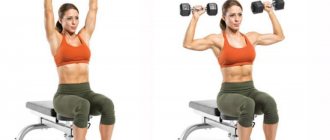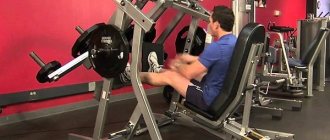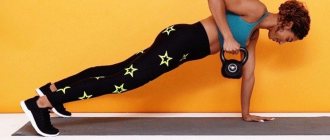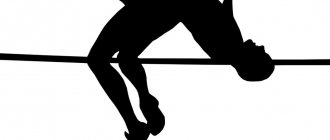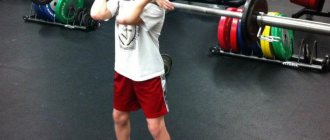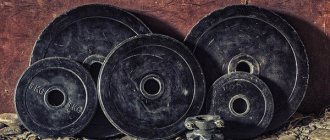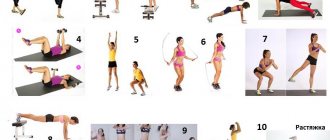A set of exercises for developing the muscles of the shoulder girdle[edit | edit code]
This complex is for those who want to increase muscle mass and strength of the muscles of the shoulder girdle, however, individual exercises in the complex are universal in nature, since to some extent they also affect other muscle groups.
Exercises for the muscles of the shoulder girdle
- Alternately raising your arms with dumbbells in front of you to shoulder level (3 sets of 6-8 times) (Fig. 6).
- Raising your arms with dumbbells from the sides up to shoulder level (3 sets of 6-8 times).
- Raising your arms with dumbbells from the sides up above your head (3 sets of 4-6 times).
- Abduction of the arms to the sides, while the torso is tilted forward (3 sets of 4-6 times) (Fig. 7).
- Alternating dumbbell chest press in a standing position (3 sets of 6-8 times).
- Circular movements of the arms with weights (3 sets of 6-8 times). (Fig. 8).
- Alternating dumbbell press in a sitting position (3 sets of 6-8 times).
Exercises for the muscles of the shoulder girdle
- Abduction of the arm to the side, lying on an inclined bench on the side (3 sets of 4-6 times) (Fig. 9).
- Raising your arm to shoulder level while lying on a bench on your side (3 sets of 4-6 times) (Fig. 10).
- Abduction of the arm to the side with a dumbbell, lying on your side on a bench (3 sets of 4-6 times).
- Abduction of arms to the sides, lying on your stomach on a bench (3 sets of 4-6 times) (Fig. 11).
- Raising your arms forward while lying on your stomach on a bench (3 sets of 4-6 times).
- With crossed arms, hold the handles of the exercise machine in the forward tilt position. Overcoming the resistance of the simulator, raise your arms up from the sides (3 sets of 6-8 times) (Fig. 12).
- Pull the handle of the simulator upward from the sides with one hand (3 sets of 8-10 times with each hand) (Fig. 13).
- Pull the handle of the simulator upward through the sides with one hand in the “forward bend” position (3 sets of 8-10 times with each hand) (Fig. 14).
- Abducting the arm to the side from a standing position overcoming the resistance of the exercise machine, holding the handle of the exercise machine at waist level (3 sets of 6-8 times with each hand).
- Bringing your arms to the side while overcoming the resistance of the machine in a sitting position, holding the handle of the machine at hip level (3 sets of 6-8 times).
- Pulling the barbell to the chin in a standing position (3 sets of 6-8 times).
- Hand press of a barbell from behind the head in a standing position (3 sets of 5-6 times).
- Lifting the barbell with straight arms while lying on your back. At the beginning of the next repetition, the barbell is on the hips (3 sets of 4-6 times).
- Bench press a barbell with a narrow grip from a lying position, holding it briefly on straightened arms for 3-4 seconds (3 sets of 4-6 times).
The indicated number of repetitions in this set of exercises corresponds to the physical capabilities of athletes with little experience of independent training (3-6 months), after 3-4 months of working with such a load, the number of repetitions should be increased by 15-20%, and after six months, more should be added to each exercise 1 approach.
A little anatomy lesson
The shoulder complex includes the humerus, collarbones, thoracic spine, rib cage, and shoulder blades. His strength is the huge range of movements he can perform. The disadvantage is dependence on many ligaments and muscles at once. If these muscles are overused or improperly used, the shoulders lose mobility.
To avoid pain, all four joints must function properly. At a minimum, it’s worth stretching your shoulders throughout the day: moving back and forth, up and down, rotating. But if you still feel tense in the evening, 16 simple exercises will help you.
Karina Wu
physical therapist, owner of a physical therapy center in New York.
These exercises will help you relax and improve your flexibility. But first you should pay attention to your posture.
A set of exercises for hands[edit | edit code]
First level
- Knee push-ups
- Push-up
- Retraction of hands with the ball behind the head
- Army press
- Rotating around your head
- Clean up
- Overhead press
- Kettlebell Bench Press
- Medicine ball rotation
Advanced level
- T-turn push-up
- Retraction of hands behind the head with weights
- Shoulder press
- Diver
- Push press
- Ball push-ups
- Push-ups with simultaneous lifting of the torso and legs
- Passing the ball
- Underhand grip pull-up
- Overhand grip pull-up
Professional level
- Ball push-ups with alternating hands
- Side push-up with simultaneous lifting of the torso and legs
- Push-up from the bar
Tricks for visually widening your shoulders
A narrow waist visually widens the shoulders. If you have a beer belly, do some cardio and adjust your diet. This way you can give a V-silhouette to your figure.
Choose pants and shirts (jeans and T-shirts) in a “slim” style. In other words, clothes should be tailored, fitted and slightly tapered, but not too tight.
A couple more tricks when choosing clothes: horizontal patterns (especially in the chest and shoulders), as well as white color, visually expand the upper body.
Read also[edit | edit code]
- Forearms - exercises and training
- Shoulders - exercises and training features
- Biceps - exercises and training features
- Triceps - exercises and training features
- Specialized training, hands
- Arm training program
- An effective program for pumping up your arms
- Arm exercises (for women)
- Training program with an emphasis on arms
- How to pump up arm muscles
- How to pump up your shoulders (deltoids)
- Shoulder training in the gym
Posture correction
From a standing position, lean forward slightly, hunching slightly. Do not overdo it. Then straighten up. Repeat 3-5 times.
Ask someone to place their thumb between your shoulder blades and remember the sensation at this point so that next time you can concentrate on it without assistance.
To position your shoulder blades correctly, move your shoulders up, back and down. Without fanaticism, a shift of just a centimeter in each direction is enough. Repeat 10 times.
Preventing neck and shoulder pain
Pain in the neck can be different - pulling, throbbing, shooting, tingling. To minimize the occurrence of such symptoms, you should adhere to the following recommendations:
- As mentioned, raising your laptop, book, tablet or cell phone to eye level can relieve pressure on your spine. Buy a reading stand or adjustable table. If you use a computer at an office or desk, adjust your chair and monitor to suit your height.
- Set a timer to remind you to get up, walk around, and straighten your back at least once every hour.
- Stretch regularly. Stretching exercises help improve posture and reduce musculoskeletal pain.
- Don't sleep on a high pillow. Firstly, it is impossible to maintain an anatomically correct position with it, and secondly, because of it, the vertebral arteries that feed the brain and allow it to function normally can be compressed.
- When talking on the phone, do not hold your smartphone between your head and shoulder. If you use this method frequently, switch to a headset or speakerphone.
- Avoid carrying bags and backpacks on one shoulder, be sure to change their order, and also remember that the weight of the bag should not exceed 10% of your body weight. If it is heavier, and especially if you wear it constantly on the same side, it can cause curvature of the spine, and, as a result, pain.
- Get a massage. It helps relieve muscle spasms, improves blood circulation, and also increases range of motion by removing accumulated lactic acid.
Don’t bypass sets of exercises for the neck and whole body. It is very important to maintain a toned core, which consists of the muscles of the abdomen, back and buttocks. If they are in good shape, then this allows you to stabilize the spine, preventing it from sagging and deforming. And healthy posture plays a key role in neck health.
It is also important to take measures to prevent osteoporosis. Loss of bone mass in the spine can lead to injury, slouching, and increased pain.
Fabrics and movement
Before looking at the shoulder, let's take a look at the human movement system as a whole. Remember, this is just an overview; trainers need to go deeper into the topic before creating corrective exercise programs for clients with shoulder dysfunction.
Connective tissues have different elastic-viscous properties, greater or lesser density and are designed to withstand everyday stress. Under normal conditions, they respond to load differently depending on the speed, magnitude and duration of the force applied (Magee et al. 2007).
Each type of fabric has its own purpose and unique abilities. Dense connective tissues of bones, ligaments, and tendons are rigid and can only elongate 10% before breaking. Because of their relative inflexibility, dense tissues protect the extremes of the range of motion, but their injuries are widespread. Loose connective tissue is much more pliable. Loose tissues of the joint capsule, muscles, nerves and other sites can elongate up to 80% of their resting state without structural strain (Magee et al. 2007). This is very important for fitness professionals to know, because from the moment the load shifts primarily to the damaged, denser connective tissues, any errors in technique or movement control will significantly increase the risks.
Tissue is damaged when it can no longer withstand the stress and deformation caused by rapid force development, angle, duration and frequency of application. The manifestation of such common consequences of repeated overuse as tendonitis and bursitis of the shoulder is usually preceded by a movement disorder. A good personal trainer can identify these types of problems before they become injury. In this case, exercise therapy can be used to help correct the impaired movement pattern (Sahrmann, 2001).
Training Recommendations for Broad Shoulders
In order for a man to make his shoulders wider, he needs to adhere to the basic principles of deltoids training. Let's look at all these points:
- The basis of the training should be basic exercises that promote muscle growth. In addition, we recommend “finishing off” the shoulders with insulating elements.
- Strength exercises to broaden the shoulders should be done once a week to avoid overtraining. It is permissible to combine such activities with leg or back training.
- In order for the deltoids to grow and expand, it is necessary to do 3-4 sets of 8-12 repetitions in each basic exercise , and 3-4 sets of 12-15 repetitions in isolating exercises.
- It is difficult to pump up broad shoulders at home. But you can still achieve good results with pull-ups, push-ups, or parallel bars. Read more about shoulder training on the horizontal bar and parallel bars.
How to do yoga exercises
Follow the rules carefully and do not hold your breath. Maintain each pose for 30 seconds.
Half bend forward with emphasis on the wall (simplified uttanasana)
Stand straight, two steps away from the wall, facing it. Place your feet hip-width apart for comfort. From this position, bend at the hip and lean forward with a straight back to a 90° angle between your body and legs. Place your hands on the wall.
Try to straighten and stretch your spine as much as possible. Hold the pose for 20–30 seconds.
Warrior Pose II (Virabhadrasana)
Stand up straight, spread your legs wide, point your toes forward, raise your arms to the sides, connect and straighten your fingers.
Turn your right foot 90° to the right. Bend your right leg at the knee to a right angle or close to it, and move your left leg back. Distribute your weight between both legs.
Twist your pelvis, stretch your back, lower your shoulders. Try to open your pelvis and chest. Repeat the pose on both sides.
Twisting (Bharavajasana)
Sit on the floor, bend your right leg at the knee, point your shin outward and place your heel next to your pelvis. Bend your left leg at the knee, place your left foot on your right thigh.
Distribute your weight between your two sitting bones and lengthen your spine upward. Place your right hand on your left knee and turn your body and head to the left, grab your left toe with your left hand. Repeat on the other side.
How to pump up a man's shoulders (without equipment)
You can pump up your shoulders at home without dumbbells. Your own weight is quite enough to achieve toned, sculpted shoulders. The most important thing is to follow a program of exercises that comprehensively affect the deltoids and develop them symmetrically. The program below offers functional upper body exercises that will help pump up the shoulders of a man without dumbbells.
Cross-shoulder push-ups
Take a classic lying position, fixing your palms slightly wider than the vertical of your shoulders. Make sure that your back does not slouch or sag towards the floor. As we inhale, we lower our body weight, stopping a couple of centimeters from the floor, after which we do push-ups, exhaling. Now you need to touch your left palm to your right shoulder and begin performing the next repetition. After pushing up again, touch your right palm to your left shoulder (and so on in turn). Throughout the entire approach, maintain an average pace of work and avoid sudden jerky movements. In addition to the fact that the exercise helps to pump up your shoulders at home, it additionally develops the pectoral muscles and helps to increase the size of the triceps.
How much to do: 10-15 push-ups in 2 sets (increase the number of sets as needed if you plan to do not all 12 exercises, but only part).
Side plank arm raise
Assume a side plank position with your forearm supported. To begin, focus on the right side. After taking the position, make sure that the line of the neck, back and legs is straight. The left arm is extended along the body and pressed to the side. As you exhale, we lift the upper limb to a position perpendicular to the floor, and then lower it back. Having completed the planned number of repetitions, change sides and proceed with the already familiar technique. If you can’t pump up your shoulders at home with dumbbells due to the lack of sports equipment, this element demonstrates an equally high-quality effect, emphasizing the load in the middle fascicles of the deltoids and simultaneously working the core and abs.
How much to do: 13-15 lifts in 2 sets.
"Butterfly" with arm curls
Lie down on a gymnastics mat with your stomach down, then slightly raise your body. In the starting position, the arms are extended in front of you and held parallel to the floor surface. Now, as you exhale, we begin to move our arms back, bending them at the elbow. To make it easier to master the technique, imagine that you are doing a shoulder press. At the peak point, take a short pause, then stretch your upper limbs back. To create additional stress on the lumbar region, watch the position of your legs. They should not leave the mat throughout the entire range of motion. The exercise not only helps to pump up a man’s shoulders with an emphasis on the middle and back buns, but also works the latissimus dorsi muscle, helps straighten his posture and strengthen the lower back.
How much to do: 13-15 pull-ups in 2 sets.
Up-down plank
Take a standard lying position similar to the first exercise from today's workout. The specificity of the presented element lies in the alternating change in body position from a lying position to a classic plank (and vice versa). In the starting position, make sure that the line of your neck, back and legs is straight. When moving into a plank position, do not allow your back to slouch or your torso to sag toward the floor. Remember to alternate sides: first step down with your left hand, then with your right. In this case, the exercise will help strengthen the arms as a whole, focusing on the front deltoids, and also helps to work out the muscular corset and triceps.
How much to do: 9-10 lifts with each arm (18-20 lifts in total), repeat in 2 sets.
Pike push-ups
We assume a downward-facing dog position. To do this, you need to raise your pelvis so that your body takes the shape of an isosceles triangle. The palms are fixed slightly wider than the vertical of the shoulders, the back is straight, the legs do not bend at the knee. Next, as you exhale, lower your torso to the floor, stopping a couple of centimeters away from it. Elbows spread out to the sides and do not wag from side to side. While inhaling, we return to the starting position, after which we cycle the exercise and do the required number of repetitions. The main effect of such push-ups is expressed in the form of an increase in the volume of the anterior and middle bundles of the deltoid muscles.
How much to do: 13-15 push-ups in 2 sets.
Raises arms forward and sideways in plank
The final exercise is performed in a lying position. Its essence lies in alternately stretching your arms in front of you and to the side. First, we work with the left hand, raising it to a position parallel to the floor, so that at the peak point the limb becomes a kind of continuation of the body line. Return your left hand to the floor and then move it to the side so that it becomes perpendicular to the body. Then do the same work with your right hand - stretch it first in front of you, then to the side. This exercise will help you pump up your shoulders at home, focusing on the anterior and middle deltoid muscles.
How much to do: Complete 20 arm raises on both sides in total, repeat in 2 sets.
Ready-made programs for men (without equipment):
- Ready-made training program for the whole body (for 5 days)
- Ready-made training program for losing belly fat (3 days)
- Ready-made training program for weight loss and body tone (for 3 days)
- How to remove sides and belly for a man (two ready-made workouts)


